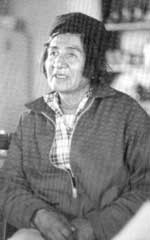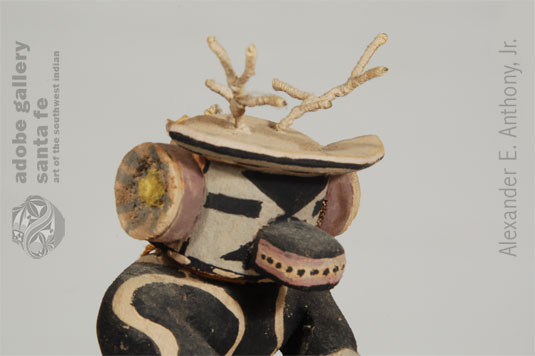Hopi Deer - Sowi-ing Katsina Doll by Jimmy Koots [SOLD]
+ Add to my watchlist Forward to Friend
- Category: Traditional
- Origin: Hopi Pueblo, Hopituh Shi-nu-mu
- Medium: wood, paint, string
- Size: 9-3/4” height
- Item # 26042 SOLD
 It is believed that Katsinas embody the spirits of living things and the spirits of ancestors who have died and become a part of nature. It is believed that Katsinas possess powers over nature. Katsinas are personated by men of the village and, in doing so, they become the supernatural with all the powers associated with the supernatural Katsinas. As supernatural beings, they may cure disease, grow corn, bring clouds and rain and reinforce discipline and order in the pueblo world.
It is believed that Katsinas embody the spirits of living things and the spirits of ancestors who have died and become a part of nature. It is believed that Katsinas possess powers over nature. Katsinas are personated by men of the village and, in doing so, they become the supernatural with all the powers associated with the supernatural Katsinas. As supernatural beings, they may cure disease, grow corn, bring clouds and rain and reinforce discipline and order in the pueblo world.
Animal Katsinas, in addition to possessing those functions, have the power to strengthen the chance of abundant animals for hunting season. Hunting animals for the pueblo natives is not a sport but a necessity for provisions for the winter. There are Katsinas representing Deer, Antelope, Rams and other hunt animals. This doll carving represents the Deer Katsina, which is one of the very popular Plaza Dance participants. Usually when he appears, a Wolf or Mountain Lion Katsina, as a side dancer, accompanies him. The Deer Katsina has power over rain, and, when he dances, it is a prayer for increase of deer.
Presumably the first Deer Katsinas were brought from the prehistoric Hopi village of Awatowi, which may be correct as they retain a strong Rio Grande appearance.
The position that this katsina usually assumes, when he dances, is that of bending forward at the waist, as he is depicted in this carving. The doll stands firmly without use of support. His antlers were constructed of wire, then wrapped with string. His elaborate white belt with sash was hand woven from white cotton string.
This carving by Jimmy Koots well illustrates the fine craftsmanship he evidenced over his career. He was born at Hopi Pueblo on the Third Mesa village of Hotevilla during the period of World War I. At a very young age, he and many other Hopi children were removed from their homes and taken to government schools where they were to be assimilated into the White man's culture while being stripped of their Hopi beliefs and heritage. Koots survived the five long years at the Bureau of Indian Affairs School and then returned to his native village.
At age 22, Koots was again taken away from his native village and sent off to the Pacific to fight in World War II. Following this war, he once again returned to the village of Hotevilla. It was then that he discovered that the big oil companies and the government were colluding to remove the Hopi from their reservation because of the wealth of mineral resources—coal, gas, oil and Uranium. He became an activist against strip mining and the big corporations. Because of his and many other's efforts the Hopi retained their native land.
Jimmy Koots was among a group of Hopi who revived the ancient art of traditional Hopi Katsina carvings. He was immensely popular in the 1960s and 1970s as a katsina doll carver. His dolls were mostly sold in Santa Fe at a downtown shop called Rare Things by Dutton, a business that is now closed but was very active in the 1960s-1980s. His carvings, although not signed, are so distinctive in appearance that they can be easily identified as his work. This carving, as usual, is not signed with the name of the carver but it is without question the work of Jimmy Koots and was probably carved in the 1960s.
Condition: this Hopi Deer - Sowi-ing Katsina Doll by Jimmy Koots is in very good condition. No evidence of repairs.
Provenance: from a Santa Fe resident
Recommended Reading: Fewkes, J. W. Tusayan Katcinas. Washington, D. C. Bureau of American Ethnology, 15th Annual Report, 1897.
Jimmie Kootshongsie photo courtesy of Gregory Schaaf.
Photo reference: Hopi Katsina: 1,600 Artist Biographies by Gregory and Angie Schaaf.

- Category: Traditional
- Origin: Hopi Pueblo, Hopituh Shi-nu-mu
- Medium: wood, paint, string
- Size: 9-3/4” height
- Item # 26042 SOLD



